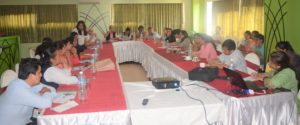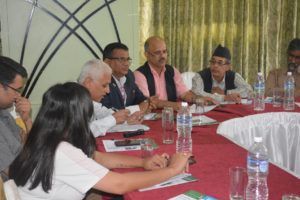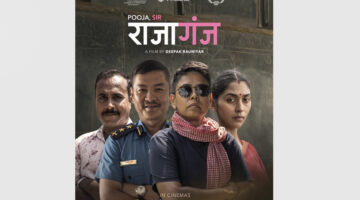“Report on media monitoring content published from Freedom Forum has motivated us to build gender friendly newsroom as we are regularly monitored from gender perspective,” said Editor-in-Chief Bimal Gautam at Lokantaar online news portal.
Gautam expressed his views in an interface organized by FF on August 27, 2019 where participants were from media fraternity.
In the event, Freedom Forum Media Monitoring Officer Narayan Ghimire briefed about the objective and scope of monitoring media contents through gender perspective. He stressed that after the research on media content by FF, data on women representation in media houses have been gradually improving.
Media Monitoring Coordinator Nanu Maiya Khadka highlighted the methodology and presented the finding of media content monitoring from 2017 to 2019. According to the report, there was 9% female byline and 91% male byline in print media in 2017 which remained same in 2018. Similarly, there was 11% female byline and 89% male byline in online media in 2018.
In the six months since January 2019, the print media recorded 12% female byline and 88% male byline; while in the same period, the online media recorded 18% female byline and 82% male byline. The report concluded gradual improvement in the participation of female in news byline and as news sources in both print and online media.
On the report and its findings, representatives from different media expressed their views and opinions on need for inclusive newsrooms in the media houses.
Adding to this Editor from Lokantaar, Gautam also suggested FF to conduct research on media coverage on local governance and RTI issues.
 Advocate Pabitra Raut showed her concern towards lack of internalization of gender inclusive newsrooms at editorial level. She further suggested that women should be included in both management as well as newsrooms for their quantitative and qualitative participation.
Advocate Pabitra Raut showed her concern towards lack of internalization of gender inclusive newsrooms at editorial level. She further suggested that women should be included in both management as well as newsrooms for their quantitative and qualitative participation.
Senior Journalist from Himalaya Times daily Rama Luitel questioned whether news on social and other issues can be prioritized into so called mainstream beat in the media contents.
On the other hand, Trishna Acharya, Head of Journalism Department at Divya Bhumi Multiple College, praised the study for being useful for further research and that the research should also be linked to academic discourse.
Furthermore, Editor from The Himalayan Times daily Prakash Rimal appreciating the monitoring report said that every beat/ page of newspaper is the priority for an editor. He also shared that THT has recently recruited 3/4 female journalists for THT online and further suggested to expand the study for women’s presence in managerial section of media in addition to byline and news sources.
Editor Rimal also shared that THT has many female journalist as department heads who contribute to the contents but their name are not visible through bylines.
Director from Department of Information and Broadcasting, Suman Bajracharya shared the data that among 3363 journalists accredited at the department 16% are female, and among 412 editors accredited 48 are female. She said that increasing online media might have contributed to the increasing data of female editors. Also, media houses could build policies to encourage and retain more women in the media sector, she urged.
Journalist from Himalaya TV, Srijana Ghimire suggested to incorporate broadcast media in the research and further said that female is different biologically and therefore, it is important to have gender friendly work place. Policy changes brought after women journalists’ reporting should also be included in the study, she stressed.
Editor from Himalaya Times, Govinda Luitel while calling upon all the media to adopt 50:50 strategies as like that of BBC 50:50 project also highlighted that women should be appointed as spokesperson or information officer for their increased participation as news sources. Sensitization at editorial’s level is important and female journalists themselves should also share their problems with the management, he argued.
Likewise, President of WWJ, Amika Rajthala shared her experience on how she was not promoted at work in the past when she was on maternity leave. She also claimed that female are not promoted to editorial level and still we lack female journalists in the editorial department.
Meanwhile, Vice President of FF, Sahajman Shrestha raised the question about most of the media houses that lack media guidelines to ensure good environment for female journalists.
General Secretary of Freedom Forum and former chairman of FNJ, Dharmendra Jha urged media houses to abide by the Working Journalist Act which will also encourage women’s presence in the media.
Journalist at www.nepallive.com, Pushpa K.C asked a question, ”Why don’t media houses arrange breast feeding room, so that women could be regular at work?”
Likewise, journalists from different media houses talked about women not getting unequal opportunity and pay gap among women and men and also media houses’s trust upon women journalists on reporting important issues.
Secretary at National Women Commission , Dipendra Kafle stated that he was disappointed to know low representation of women in the newsroom. Further, he also committed that media content monitoring report published by FF will be incorporated in the annual report of NWC .
FF executive Chief Taranath Dahal asked editors to capacitate and appoint female journalists in their media houses. He stressed that the report published by FF will help to bring change in media and also urged media houses to develop gender policy.
Lastly, FF’s Chairperson, Hari Binod Adhikari thanked all participants as well as monitoring team for the research report and concluded the program calling upon the media houses to develop gender inclusive news room and news contents.
The program had 32 participants; out of which 22 were female and 11 male participated in the event from diverse sectors.





